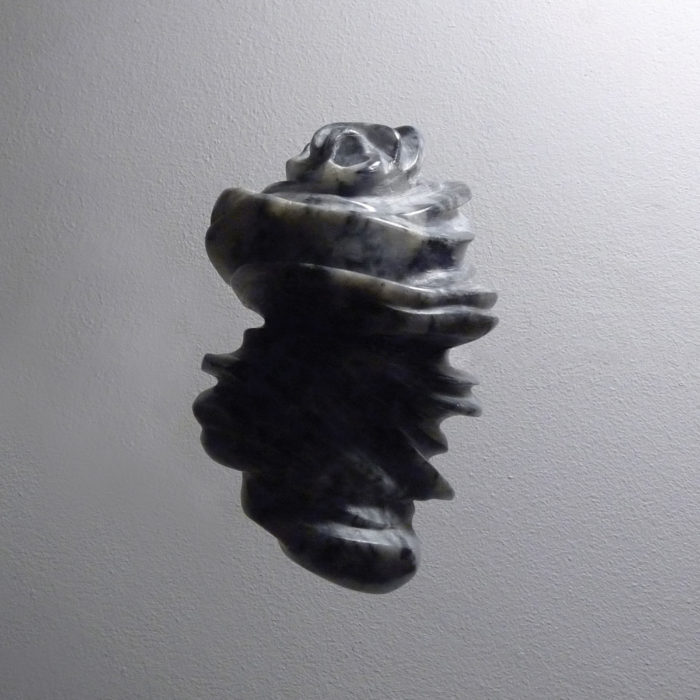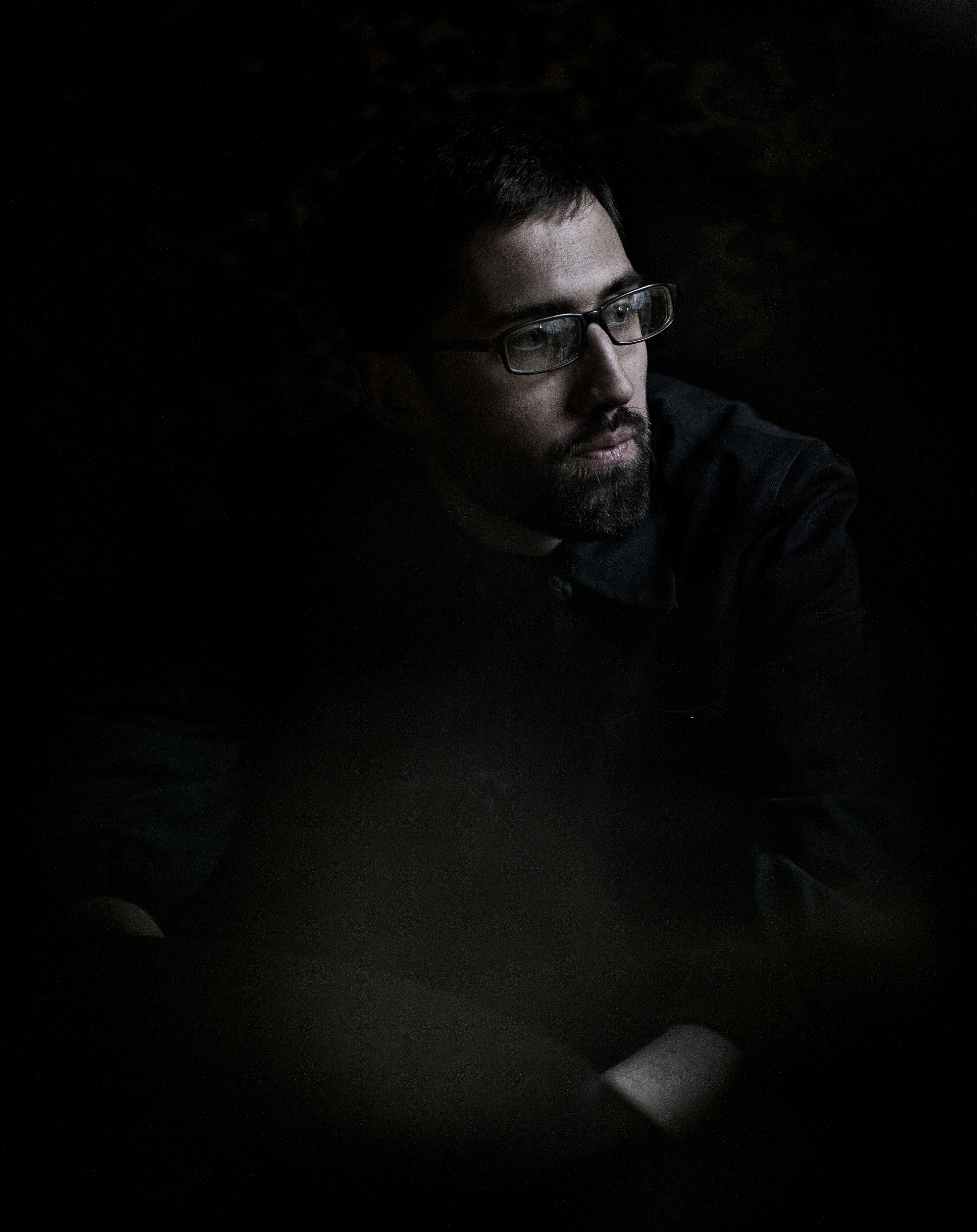Koenraad Ecker’s 2nd album is a fascinating headlong dive into experimental sound and amplified acoustics. Its linear sounds and silences, often surprising and unsettling, remind me of the boldest musique concrete of pioneers Bernard Parmegiani or Pierre Schaeffer. It’s unclear as from where most of Ecker’s sounds originated, but their amplification, juxtaposition, and contrasts to one another make for some pretty intense and fascinating listening. I hear weather, electronics, and objects, often hard to separate from one another, along with conspicuous use of silence for optimal impact. The repetitious microtones of “Kreupelhout” add a strange sense of urgency or alarm to Ecker’s otherwise somnambulant and vague atmospheres. “There Are No Eyes Here” has all of the tension of vintage Penderecki or Bartok, atonal string drones and harmonics vying for position in an otherwise stark, cold landscape.
At times it’s downright scary, a disorienting cloud of drones, tones, scrapes, and textures. “Shadow Puppets” leads with a thunderous strike of piano bass before a colloidal flutter of sound consumes it, like a thought that hasn’t quite fully resolved itself. Clicks and pops of wet reverb pierce the vibrating atmosphere to great effect, all tension with little resolve. Even the closing track, “Ivory Rang in the Air,” writhes with tension and nervous energy before it essentially fizzles out with a shudder. It’s best experienced as a whole to experience the full spectrum of Ecker’s sound design, wherein the lines between electric and acoustic, clarity and obfuscation become finer and less obvious. It’s a bold collection of tracks that both harken back to the new music of the mid 20th century and look forward to how those references and techniques relate to our ears in 2015. Good stuff.
(earinfluxion.com)
Music is unconscious of the world. Even pop music, even in experimental music, it does not change. Music that can be a art, I say only by this one point.
In this early part of 2015, two works have been published from Sound Art label LINE of Richard Chartier are Sound Art albums to reaffirm strongly that: Koenraad Ecker’s Sleepwalkers in a Cold Circus and NHK’s Program.
In contrast to the NHK of bare glitch Digitalism, Koenraad Ecker is, it is possible to use a pale sound of analog synthesizers in multilayered, is realized somewhere contemporary musical composition. When There is also the moment, such as Gagaku, even or I think “Toru Takemitsu translated into electronic music?” In the noise, like a fog, I think of a techno beat melting, this tricky music is appealing. Materials collide, sound and movement are generated like a object… a monochrome sound object.
Apparently, there seems also of music for contemporary dance, and have won the acoustic motility.Therefore whether body is dislocated from normal motility. Also, I feel also similarities with the sound of Eric M… Whereas NHK’s sound is a noise that emphasizes the treble part, Koenraad Ecker uses thick noise / sound from midrange, such as to shake around the low frequencies. I should say that even with the vibration and the chain of sound emitted from analog electronic machine. Personally, I feel that this sounds like cutting edge Western experimental music. Stone buildings, sounds of distant memories of a church. This work, it is also a work has been joined to industrial music, movement, be said to also as “noise music” that is common to modern / state-of-the-art electronic music. Very modern noise music.
… Koenraad Ecker’s music, is located in the industrial state-of-the-art… the sounds that are present in the later Western Modernism. There is also difference of digital electronic sound and analog electronic sound. Although is the presence of bipolar In that sense, it is at the same time, minimal, noise, instability, even in sound also be in common with keywords: light / black… Music that established by the light / black is a post-post-digital music. Classification of digital and analog disappears herein. This is what is the new electronic experimental music of the new era. New electronic music, representing at the world where the human is lost. The sound of poor electrical contacts, electricity, also that of analog synth noise, even if humans disappeared, so, as long as there is power (might time it was limited) it seems sound to continue. To continue sounds in the world with no people. These new two works of LINE form a piece that symbolizes the beginning of this era.
Once LINE curated the post-digital music. But, now I have to rush to the world of post “later”. So to speak area of post-post-digital music, here it is. It’s like the best/top 2015 electronic music has already decided.
(ele-king.net)
There’s a microcosmic symbiosis happening within the morpho-spacemacro-structures that reveals an unfinished dimension of listening. Koenraad Ecker proposes here a sober take on that, through a syncretism towards the difference and dissection of timbre, thus expanding the figurative paradox of silence/resonance in order to find a dynamic space between its tension and segregation. Multiple, subtle, obvious and hidden microtones are well spread and interchanged; clouds flow gently among almost imperceptible grains, together with unexpected objects and both surprising and cautious situations, maintaining a faint slowness of endless singularities; intriguing, able to expel the ears from their comfort zone to catch the listener in an itinerant need, employing perplexity as aesthetic function and focusing a rhizomatic aspect of sound in which the inter-connection of the pieces embraces diversity and exposes it as richness.
(infinitegrain.com)
Nothing like a sleep deprived night to make you more attuned to the sounds of Koenraad Ecker, one half of improvisers Lumisokea, the Belgian one of the duo this week – I had his mate a couple of weeks back splattering my ears with all kinds of sonic cacophony, via the renowned Opal tapes.
Once again trading in a deliciously spectral electro-acoustic phenomena derived from intimately-placed recording devices in order to capture otherworldly frequencies, found sound, glimmering oscillations, concrète noise and fluttering shards of glitch, all laced with an especially nice line in dark ambient tonal menace. Some stunningly sharp editing processes make this a consistently riveting listen. Sounds you’ve never heard surgically segued, a cornucopia of futuristic, scary noises creeping stealthily through the very eye of your mind.
Rather than a mere collection of random experiments in aural darkness, there is a lot of beauty to be found in these intoxicating and eerie pieces, his adventurous recording methods adding an extra element of tactility; the snippets of chamber-like avant classical experimentation are both breathtaking and ominous. From brief glacial ambience to metallic scree could be jarring in the hands of a lesser artist but I find this a profoundly interesting and consistent body of sonic sculpture bulging with numerous possibilities and ideas.
Like so many artists today trading in their refined visions of what sound juxtapositions make true art, their work needs to be appreciated via quality in-ear devices or amplified in a huge dark space to truly glean all the fascinating detail and wonderful resonance. It’s amazing considering the enormous array of consistently differing sounds how succinctly this dark excitable mass of ideas flows, Including everything from bursts of moribund cello to sinister electronic machinations, dingy off-beat submerged kicks and bizarre cyber-tropical aural clutter this is one hell of a fascinating excursion from a man who has only one album on Digitalis previously to his name. Take your time lad, there’s enough happening here to keep us entertained for months.
One of the most sonically arresting releases I’ve heard on LINE since the last Chartier/Basinski collaboration. (8/10)
(normanrecords.com)
Second solo album from Lumisokea’s Koenraad Ecker, following an LP on Digitalis last year. Cold electro-acoustic drone with metallic rustling and scraping and bass tones. Builds tension and suspense but never really releases it. The closest it gets is the swarming strings and electronic birdsong of “There Are No Eyes Here”, and the harsh cutups and ominous beats of “Nazif”. “Parasites” develops a shuddering, convulsing beat, providing one of the more rhythmic moments in the album, which otherwise has a dark, sickly metallic drift.
(theanswerisinthebeat.net)
Car à l’intérieur c’est un palais des glaces (j’aurais pu dire aussi un miroir à facette qui renvoie les sons les uns contre ou sur les autres). L’électronique « normale » comme un président se transforme au fur et à mesure au contact d’un field recording ou d’un nouvel instrument (une voix, un saxophone, un violoncelle, etc.). De salle en salle (car l’objet bizarre en comporte plusieurs, de salles) les ambiances se succèdent comme dans un film d’horreur ou (non, ce n’est pas au choix, mais bien tout en même temps) dans un peinture onirique. On n’en finit d’ailleurs pas d’écouter partout, et si le torticolis auriculaire existait, je n’en remercierais pas moins l’épatant Ecker d’en avoir été la cause.
(le son du grisli, France)
this is why i love i love experimental music so much, is records like this.
(theantidotepodcast.com)


